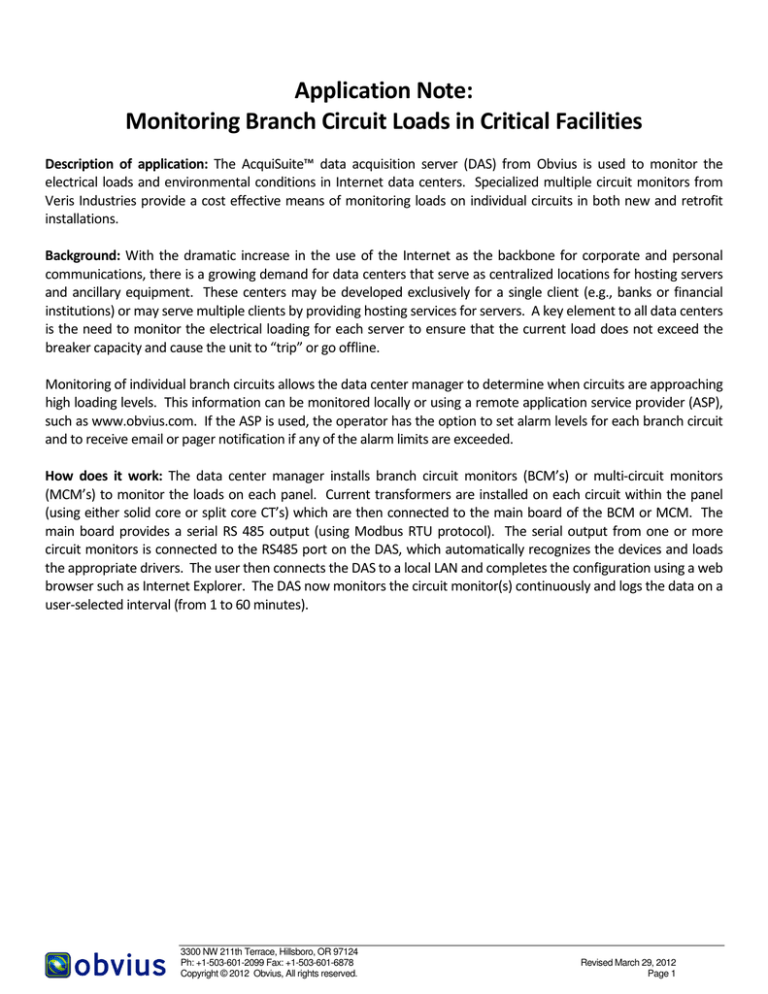
Application Note:
Monitoring Branch Circuit Loads in Critical Facilities
Description of application: The AcquiSuite™ data acquisition server (DAS) from Obvius is used to monitor the
electrical loads and environmental conditions in Internet data centers. Specialized multiple circuit monitors from
Veris Industries provide a cost effective means of monitoring loads on individual circuits in both new and retrofit
installations.
Background: With the dramatic increase in the use of the Internet as the backbone for corporate and personal
communications, there is a growing demand for data centers that serve as centralized locations for hosting servers
and ancillary equipment. These centers may be developed exclusively for a single client (e.g., banks or financial
institutions) or may serve multiple clients by providing hosting services for servers. A key element to all data centers
is the need to monitor the electrical loading for each server to ensure that the current load does not exceed the
breaker capacity and cause the unit to “trip” or go offline.
Monitoring of individual branch circuits allows the data center manager to determine when circuits are approaching
high loading levels. This information can be monitored locally or using a remote application service provider (ASP),
such as www.obvius.com. If the ASP is used, the operator has the option to set alarm levels for each branch circuit
and to receive email or pager notification if any of the alarm limits are exceeded.
How does it work: The data center manager installs branch circuit monitors (BCM’s) or multi-circuit monitors
(MCM’s) to monitor the loads on each panel. Current transformers are installed on each circuit within the panel
(using either solid core or split core CT’s) which are then connected to the main board of the BCM or MCM. The
main board provides a serial RS 485 output (using Modbus RTU protocol). The serial output from one or more
circuit monitors is connected to the RS485 port on the DAS, which automatically recognizes the devices and loads
the appropriate drivers. The user then connects the DAS to a local LAN and completes the configuration using a web
browser such as Internet Explorer. The DAS now monitors the circuit monitor(s) continuously and logs the data on a
user-selected interval (from 1 to 60 minutes).
3300 NW 211th Terrace, Hillsboro, OR 97124
Ph: +1-503-601-2099 Fax: +1-503-601-6878
Copyright © 2012 Obvius, All rights reserved.
Revised March 29, 2012
Page 1
Figure 1 - Setup screen for alarms on BCM
If alarm levels are not exceeded, the DAS simply stores the interval data in non-volatile memory until the next
scheduled time for the DAS to upload the data to the ASP web site. The DAS initiates an HTTP request using a local
LAN connection and pushes the interval data from the local site to the database server where it is available for
display to authorized users with Internet browsers (see “Reports” below).
If an alarm is received, the DAS initiates an immediate upload to the ASP and the ASP sends out email or pager
notification to the users who have requested to be notified on alarms. The alarm message indicates which point is
alarm, what the value of the monitored load is and the time the alarm was received. The alarm notice can be sent
to multiple users.
Benefits: The data center operations manager benefits in many ways from the monitoring program, with primary
benefits being:
•
•
•
Load management – By tracking the loads on each circuit on a 24/7 basis, the operations team is able to
determine which circuits are nearing capacity and which can accept additional loads. This information can
be very useful when new capacity is required to avoid overloading branch circuits with new servers or
ancillary equipment
Alarm notification – Alarming at levels below the trip point of the circuit breaker allows the operator to
detect potential problems before they result in costly downtime of equipment and web sites. For example,
if the operator sets an alarm point at 90% of the capacity of each circuit, the ASP server will notify the
operator in time to make adjustments in the loading and keep the systems up and running
Customer assurance – Most data center operators provide QoS (Quality of Service) guarantees to customers
that address issues such as uptime. Data centers that provide continuous monitoring of electrical loads can
provide additional assurance to new and existing customers of their ability to ensure high reliability.
3300 NW 211th Terrace, Hillsboro, OR 97124
Ph: +1-503-601-2099 Fax: +1-503-601-6878
Copyright © 2012 Obvius, All rights reserved.
Revised March 29, 2012
Page 2
Drawbacks: The major drawback to the installation of monitoring equipment is in the initial cost of hardware and
labor to install the equipment (see “Costs” below). In addition, if alarm levels are not properly set, the operator may
receive “nuisance” alarms that do not reflect real problems and it may take some time to establish proper alarm
limits for each circuit.
Installation requirements: A typical installation for monitoring data center loads and environmental conditions
include the following:
•
•
•
•
•
•
AcquiSuite A8812-1 data acquisition server (DAS)– a standalone web server located on the building site that
communicates with the sensor(s), stores interval information and communicates with the remote server
H704 BCM from Veris Industries – a device that monitors the current draw on up to 42 branch circuits. The
H704 is a solid core CT unit, the H663 provides the same functionality with split core CT’s for ease of
installation in retrofit projects
E30 MCM from Veris Industries – a device that monitors the current draw on up to 84 branch circuits. The
E30 is a solid core CT panel board monitor, and the E31 provides the same functionality with split core CT’s
for ease of installation in retrofit projects
Power quality (at the primary meter and throughout the facility) can be monitored using power quality submeters such as the ION 6200, 7300 and 7500 from Power Measurement Ltd. These meters allow the
operations manager to monitor the quality of the electrical supply (e.g., harmonics, power factor, sags and
surges) in addition to the quantity of the energy used.
[Optional] – Environmental sensors (e.g., temperature, humidity, dewpoint, indoor air quality) that provide 4
to 20 mA or 0 to 10 Vdc outputs can be connected to the AcquiSuite to track indoor conditions in addition to
loads
[Optional] – On/off current sensors can be connected to the AcquiSuite to provide alarm outputs from HVAC
equipment to detect failures before they impact operations
3300 NW 211th Terrace, Hillsboro, OR 97124
Ph: +1-503-601-2099 Fax: +1-503-601-6878
Copyright © 2012 Obvius, All rights reserved.
Revised March 29, 2012
Page 3
Reports: For evaluation of load profiles on each circuit, the simplest report is a graphical indication of the loading on
each circuit:
Figure 2 - Sample display of BCM circuit load
The device list screen on the ASP site provides immediate visual indication of the status of all points on the device:
Figure 3 - Alarm indication
Custom reports can be developed using standard tools such as Microsoft Excel or Access by downloading files from
the ASP website. These reports can be developed to meet the specific needs of individual centers or customers.
Analysis/Actions: Alarm conditions will obviously dictate the actions as the operations group will need to respond
and shift loads to balance the electrical loads on each circuit.
3300 NW 211th Terrace, Hillsboro, OR 97124
Ph: +1-503-601-2099 Fax: +1-503-601-6878
Copyright © 2012 Obvius, All rights reserved.
Revised March 29, 2012
Page 4
Load monitoring curves can be used to determine where additional equipment can be added without overload
conditions and power quality meters can be used to ensure that the quality of the power delivered to the facility is
adequate.
Costs: Installation costs will vary widely depending on the number of circuits, the distance of the wiring runs, etc.,
but in general terms the cost of installing monitoring equipment for a typical panel would approximately be*:
•
•
•
•
•
AcquiSuite™ or AcquiSuite EMB data acquisition server - $1,000 to $2,2,00
H704 Branch circuit monitors - $1,500 to $2,000 (per panel)
E30 Multi-circuit monitor- $3,000 to $5,000 (per panel)
IAQ sensor(s) - $100 to $1,000
Data storage and reports - $20 per month per AcquiSuite™
* General figures based on available information; contact Obvius for the latest pricing
Notes/miscellaneous: As noted earlier, data from the ASP website is available from anywhere in the world using a
web browser and each authorized user has access to a variety of AcquiSuites. These features allow monitoring of
one or multiple sites by a single operator or many operators in remote locations, producing a substantial reduction
in the cost of operating and maintaining a data center.
For more information or a demonstration:
http://www.obvius.com
sales@obvius.com
Phone: (503) 601-2099
Toll free: (866) 204-8134
3300 NW 211th Terrace, Hillsboro, OR 97124
Ph: +1-503-601-2099 Fax: +1-503-601-6878
Copyright © 2012 Obvius, All rights reserved.
Revised March 29, 2012
Page 5

